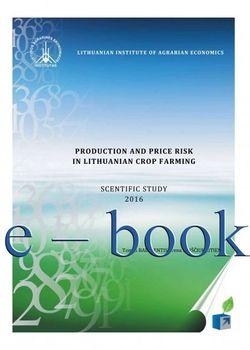
Agricultural sector requires analysing and managing multiple risks as agricultural production might be affected to a number of unfavourable institutional, economic and environmental factors. This study aims to identify the patterns of production and price risk in Lithuanian crops farming. Specifically, we look at two interrelated types of risk and their impacts on farm revenue. The following tasks are, therefore, set: 1) to define the methods for the analysis of insurance premium and changes in the revenue; 2) to describe the main spatial and temporal trends in Lithuanian crop farming; 3) to estimate the insurance premia for main crops and regions; 4) to analyse factors influencing revenue change. The study applies linear moving averages for analysis of trends in yields and prices. Insurance premia are modelled by fitting statistical distributions via the Maximum Likelihood. The changes in revenue are decomposed by means of Logarithmic Mean Divisia Index. The research covers years 2000-2015. The analysis is carried out at the county level and covers 10 counties.
The period of 2000-2015 marked significant changes in terms of both cropping patterns and extent in Lithuania. The most evident trend is the increase in area sown from 1.2 million ha in 2000 up to 1.7 million ha in 2015. The highest probabilities of yield loss were observed for maize, winter barley, and spring triticale. The results indicate that maize, buckwheat, winter barley, and winter rape show the highest production risk as represented by the relative insurance premia. The spatial differences in insurance premia were also observed. The results of the index decomposition analysis suggested that the effects of the area sown, the yield trend, and the price trend were the most important in driving the crop revenue up during 2000-2015. However, different patterns can be observed for the sub-periods of 2000-2006 and 2006-2015. Crop-wise analysis implied that winter wheat, spring wheat, winter rape, and spring rape offered the most important contributions the change in the total crop revenue. Region-wise analysis also enabled to identify regions that were most important in driving the total crop revenue up.
The study is organised as follows: Section 1 presents the methods used, namely trend modelling, distribution modelling, and IDA. Section 2 describes the dynamics in cropping patterns in Lithuania during 2000-2015. Section 3 presents the estimates of production risk. Finally, Section 4 brings forward the results of the IDA.
Keywords: .
Baležentis, T.; Kriščiukaitienė, I. 2016. Production and Price Risk in Lithuanian Crop Farming : Scientific Study. Vilnius: Lithuanian Institute of Agrarian Economics. 74 p.: iliustr., santr. angl. (online) ISBN 978-9955-481-59-1.
© 2016 All rights reserved to the Lithuanian Institute of Agrarian Economics
Reference and internet address must be provided when citing
Copyrighted material
